According to Crawford in “the art of interactive design”, he believes that in interaction there should be one actor listening, considering and responding to the other, also there are different levels of interaction. Based on that, I think there can be two or more actors involved in a single Interaction. Take the Speed Game we made for example, the two participants can be seen as two inputs at the same time, and then the monitor gives the output showing the game results through the circuits we built on Arduino Uno. It’s necessary to get the intuition about what’s going on between two actors, but o make the description more academic and general, I would like to change the words “listen”, “consider” into “receive”, “process”. As Igoe and O’Sullivan put it in “Introduction to physical computing”, we need to think about the stages of input, output, and processing after you iterate your concept in plain language without thinking about the technology. (xxii) Therefore, interaction in my understanding is a process in which an actor receive and process the information from another through certain medium and then give the results accordingly.
One project I found aligning with my definition is called Aweigh. Nowadays, we are always engaged in satellite-basis interaction in daily life. If we are leaving for someplace, we will open the map. Navigation tells us where we are. This project creates an alternative positioning system based on the polarized vision of insects, rather than any company or governmental service. Combining this process with the polarization of sunlight observed in insect eyes, the group developed a technology that calculates longitude and latitude in urban as well as off-grid areas. I consider it as an interactive process because we can take the polarized light as an input, and the exact position as the output. Between them, there must be light sensors and digital components so that the light in the physical world can be converted into bytes or codes embedded in those circuits.
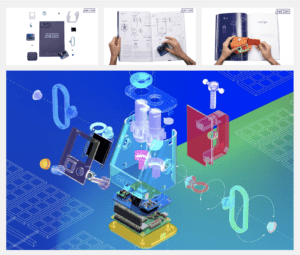
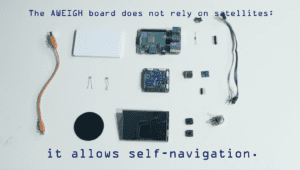
Another project comes from the exhibition I went to last semester, which is called “Quayola: Asymmetric Archaeology – Gazing Machines”. By generating data randomly through a series of complex algorithm, a whole work of art is generated accordingly. Normally, we are familiar with the works of art created by the artists, with their natural painting tools. But as is implied in the name of the exhibition, we got the change to take an insight into the relationship between art and craft, or between the humans and machine. However, it seems to be unrelated to any forms of interaction. All the data is set. Unlike the TeamLab, another exhibition I went a few months ago, the visual images here won’t change according to the physical motion detected from humans. Although we do have computer programming as an effective medium to convert bytes to visual arts, there’s lack of such inputs.
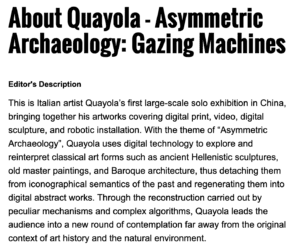
The interactive device we made is called the FitBox. It’s based on the known environment of hologram technology. The hologram is still at its starting point nowadays, where it can project the real object in a three dimensional way. But we imagine that it can be applied to the world of health and wellness, and it can have physical contact with real-life people. The FitBox functions as a workout guide. It’s portable, so it’s convenient for you to bring it to any place you like. There are basically two modes: workout mode and support mode. In the first mode, the FitBox can detect your error on your posture and pop up the hologram doing correction for you. In the second mode, the hologram will encourage you to do some exercise just to relax. In conclusion, the FixBox helps support your workout experience both physically and mentally through hologram technology. It firstly receives the information of body motion with sensors, and process it with some technology to be realized in the future, and projects “a hologram coach” as an output.
We had 4 group meetings in total. During this two-week preparation, we worked collaboratively and efficiently, from deciding on the theme to rehearsing. Our initial idea was inspired by a movie. We decided to make a medical device which can detect your disease as long as you put your hand into it. In 3 seconds, it will give a complete report about your body condition, such as temperature, heartbeat rate, etc. However, since we wanted to amplify our interactive process, instead of simply putting your hand, we turned to our alternative choice—— the FitBox. For the visual parts, I picked up a used package at the dorm and painted it blue. Also, I stuck cardboard on the front with double-sided tape to make it feel like 3D. The symbols on them indicate various functions embedded in the FitBox. Later, Lydia designed the poster with Illustrator. Jackson recorded his voice to create a robotic sound. He also writes the detailed script.
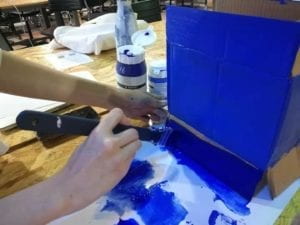
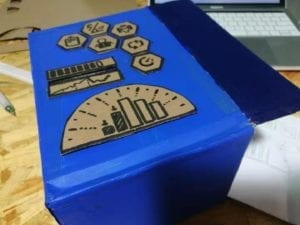
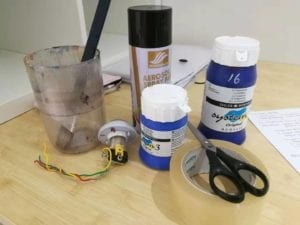
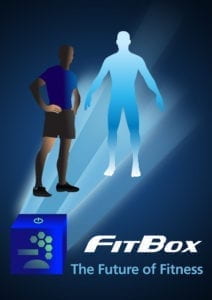
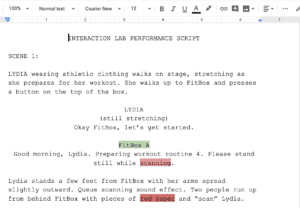
My friend asked me what’s the insight of this project when the hologram already exists in real life. I did consider it as an important fact, but just like Skype 2.0, a project from another group, I think technology is developing continuously. We inserted a lot of new interactive elements like physical contacts or emotional support into it. After the presentation, we also received lots of useful feedback. One of them shows the possibility that the principle can be used as a study guide, where you can attend the lecture in-person with your teacher in a hologram! Although our project is particularly focused on fitness, I do believe that idea equally shed light on the future of hologram.
Big thanks to my group members ( Lydia, Jackson, Eric, Emily, and Haiyan ) and our Professor Godoy.
Reference:
https://s3-ap-southeast-1.amazonaws.com/ima-wp/wp-content/uploads/sites/3/2017/08/05164121/The-Art-of-Interactive-Design-brief.pdf
https://drive.google.com/file/d/1uviCK0V71cQpA76PV9PK03Df14vcsd0y/view
https://www.creativeapplications.net/python/aweigh-open-navigation-system-inspired-by-insect-eyes/
http://www.smartshanghai.com/event/55029
https://vimeo.com/195298933
Inspiring post, Anica!